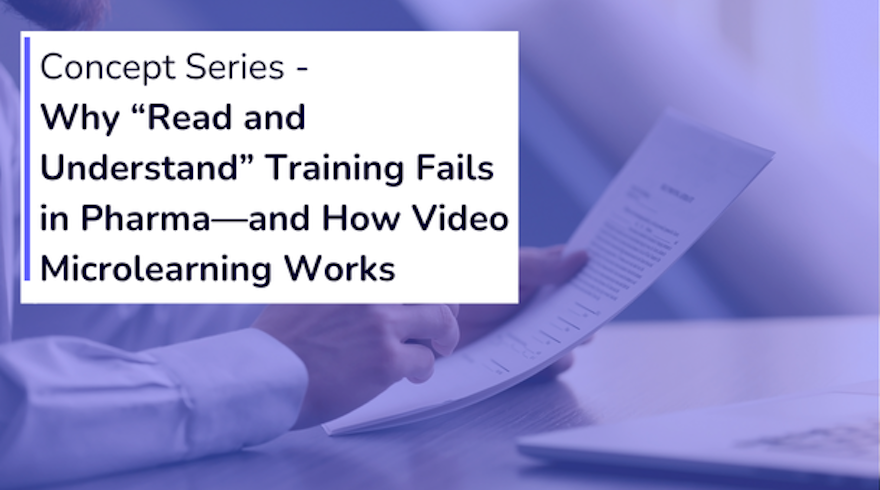Pharmaceutical companies have long relied on “read and understand” training to meet compliance requirements. In practice, this usually means giving employees dense Standard Operating Procedure (SOP) documents to read and then checking a box that they’ve “understood” them. Unfortunately, this approach is largely a procedural formality – a check-the-box exercise – rather than a genuine learning experience. As one industry analysis noted, training in pharma is often viewed as bureaucratic compliance, and employees “rarely understand what they’re doing or why,” leading to avoidable errors on the job[1]. A common training task is the oxymoronically named “SOP read and understand” assignment: employees are asked to read through dozens or even hundreds of pages of technical SOP text with no assessment to confirm understanding. It’s no surprise that many will simply acknowledge they’ve read the document without truly absorbing it[2].
The ineffectiveness of the read-and-understand model isn’t just anecdotal – it’s evident in the dismal ROI of traditional training. Companies pour enormous resources into training programs (U.S. firms spent over $92 billion on workplace training in 2023 alone)[3], yet most of that investment is essentially wasted. Research on memory retention (the classic “forgetting curve”) shows that learners forget the majority of unaided, passively consumed information. Within one day, people forget approximately 50% of new information, and within one week they forget up to 90% of it[4]. In other words, simply reading and signing off on an SOP is highly unlikely to result in long-term retention of the material. Indeed, one survey on compliance training found 34% of employees admit they only skim-read the content and tune out during training – they’re technically “completing” the training but not engaging with it[5].
Why “Read and Understand” Training Falls Short
The traditional read-and-understand approach is failing pharma companies for several key reasons:
- Passive learning yields poor retention: Simply reading text or sitting through static presentations is a passive learning model. Studies show that purely passive approaches result in extremely low knowledge retention – on the order of only about 5–10% of the material being remembered after one week[6]. Without active engagement, most of the information just doesn’t stick.
- Information overload: SOPs and policy documents tend to be lengthy and packed with details. Dumping too much information on learners at once overwhelms their working memory. It’s been reported that 78% of employees feel overwhelmed by the volume of content in typical training sessions[7]. This cognitive overload means learners can’t discern the key points, and retention plummets.
- Lack of context or application: Reading procedures in the abstract, without seeing how they apply to one’s job, creates a “learning-doing gap.” According to McKinsey research, training that is divorced from real-world application leads to poor knowledge transfer – employees cannot readily apply what they read, and retention can drop by up to 60% as a result[8].
- No reinforcement: One-and-done reading is insufficient for memory. Without reinforcement or practice, most learned information fades quickly. A longitudinal study found that without follow-up, 79% of trainees failed to recall critical information just 30 days after training[9]. The typical read/understand training provides no spaced repetition or review, so any initial learning rapidly decays.
- One-size-fits-all content: Read-and-sign training makes no allowances for different roles, backgrounds, or learning needs – everyone receives the same document. It’s not tailored to individuals. According to Deloitte’s 2024 industry survey, 82% of employees say standardized, blanket training programs do not adequately address their specific job needs[10]. This generic approach breeds disengagement: learners either tune it out or struggle to connect it to their daily work.
All of the above factors contribute to a training approach that is minimally effective. Employees rush through required readings just to comply, but real comprehension and retention are low. In regulated environments like pharma, this is a serious problem – compliance depends on employees not only reading procedures, but truly understanding and following them. Inadequate training has direct consequences. In fact, regulators frequently cite “inadequate employee training” as a top reason for FDA Form 483 observations and warning letters during pharma facility inspections[15]. A training program that leaves people clueless or disengaged creates compliance risks.
How Video Microlearning Can Drive Compliance, Engagement, and Performance
If the traditional model is broken, what’s the solution? Many pharma and biotech companies are now turning to video microlearning as a modern approach to employee training. Video microlearning means delivering training in short, focused video-based modules – typically just a few minutes long – that employees can easily watch and absorb. This strategy directly addresses the shortcomings of read-and-understand training, and evidence shows it can dramatically improve compliance outcomes, learner engagement, and job performance.
1. Better Knowledge Retention (Boosting Compliance): Microlearning is specifically designed to combat the forgetting curve by presenting information in bite-sized chunks and reinforcing key points. Rather than overwhelming learners with a 30-page SOP, a microlearning program might break that content into a series of 3-minute videos, each covering a specific procedure step or principle. Research indicates that microlearning can improve knowledge retention significantly – one study in the Journal of Applied Psychology found that microlearning approaches led to up to 60% higher retention of information compared to traditional long-form training[11]. Learners remember more, for longer. For a pharma company, this means employees are far more likely to actually recall the correct procedures when it counts (on the manufacturing floor or in the lab), directly supporting compliance. Short instructional videos can also be re-watched on demand as refreshers, and quizzes can be embedded to actively engage memory. This continual reinforcement helps ensure that critical SOP knowledge isn’t lost shortly after training. It’s telling that 18 of the top 20 global pharmaceutical companies now use microlearning platforms to train their workforce[12] – a strong endorsement that this method works for compliance. Moreover, video as a medium is compelling – it can show visual demonstrations of procedures, making them easier to understand and follow correctly. Employees often find video-based training far more clear and memorable than text; in one survey, 50% of workers said that video content helps them learn faster and retain information better than purely text-based materials[13]. By improving actual understanding and recall of procedures, video microlearning helps create a workforce that truly knows and follows the rules – reducing deviations and errors. In short, it turns “training compliance” into real compliance.
2. Higher Learner Engagement: One of the greatest advantages of video microlearning is that it captures employees’ attention in ways a PDF or slideshow never will. Well-crafted microlearning videos are visually engaging, to-the-point, and often interactive – they might include animations, on-screen prompts, or quick knowledge checks. This format aligns with how modern professionals consume content (think of how we gravitate to short videos in our personal lives). It’s no surprise that microlearning consistently leads to much higher completion and participation rates than traditional training. Industry research by the Association for Talent Development (ATD) found that switching to microlearning boosted learner engagement by approximately 50% on average compared to conventional training modules[14]. When training is delivered in small, digestible pieces, employees are less likely to put it off or tune it out. In fact, they often enjoy it more – it fits into their workday and gives a sense of accomplishment with each quick module completed. Real-world results back this up: for example, companies using Qstream (a popular microlearning platform) have reported an average learner engagement rate of around 93% for their training programs[15]. That is an extraordinarily high level of voluntary participation, far above what typical mandatory training sees. Engaged learners pay more attention and take in the material, which leads to better retention as noted above. Importantly, engagement also correlates with a positive learning culture – employees don’t dread the training; they find it useful and accessible. Video microlearning, with its mix of visual and audio elements, keeps people interested. It can even incorporate storytelling or scenario-based clips that make compliance topics more relatable. All of this matters because engaged learners are ultimately more likely to internalize and apply what they learn.
3. Improved Performance and Productivity: The ultimate goal of any training program is not just to have employees pass a quiz or sign an attendance sheet, but to improve their on-the-job performance. Microlearning has a strong track record here as well. By focusing on one concept or skill per module and often spacing the modules out over time, microlearning allows employees to progressively build competence and confidence without being overwhelmed. They can immediately put each bite-sized lesson into practice, which reinforces the learning and translates it into better work outcomes. There’s evidence that this approach yields measurable performance gains. In one study, employees trained with a microlearning strategy showed roughly 17% better performance in applying new knowledge and skills on the job compared to those who underwent traditional training methods[16]. This makes sense: when people truly understand and remember their training, they perform tasks more correctly, safely, and efficiently. In pharmaceutical operations, that could mean higher right-first-time rates, fewer deviations, and improved quality metrics. Video microlearning is also more time-efficient, which boosts productivity. Short modules delivered in the flow of work minimize disruption. For instance, Providence Health System adopted a microlearning approach for compliance and was able to reduce the time employees spend on training by more than two-thirds by replacing lengthy courses with brief learning “bursts”[17]. This freed up thousands of hours for employees to focus on their primary job duties while still maintaining compliance training standards. Less time in the classroom (or reading PDFs) and more time applying skills on the job is a win-win. Furthermore, microlearning platforms often provide analytics that allow management to track proficiency and identify who might need extra help, enabling more targeted performance coaching. All of these factors contribute to tangible improvements in workforce capability and business results. Employees who are well-trained through microlearning make fewer mistakes and achieve higher productivity, directly impacting the company’s performance.
In summary, “read and understand” training fails in pharma because it doesn’t ensure actual understanding, retention, or application of knowledge – it’s compliance in name only. The data and outcomes are clear: without engaging, reinforcing, and contextualizing the learning, most of the effort and money invested in old-school training is lost. Video microlearning offers a proven alternative. By delivering training in short, engaging video segments, it aligns with how people learn best. The approach drives significantly better retention of critical procedures (protecting compliance), captures employees’ interest (improving engagement), and boosts real-world performance metrics. It’s an approach suited to the modern workforce and the regulated environment – where training isn’t just a paperwork exercise, but a vital component of operational excellence and regulatory compliance. Pharma companies that have embraced microlearning are seeing more knowledgeable employees, more effective training ROI, and ultimately safer and more efficient operations. It’s time to evolve beyond the “read and understand” model and adopt training methods that truly enable employees to learn and perform.
References
- Mark Simon & Ben Locwin, “Why Pharma Companies Must Evolve The “Read & Understand” Model.” Pharmaceutical Online, 2022.
- Tyler DeWitt, “Workforce Training for Pharmaceutical Manufacturing Operators.” European Journal of Parenteral & Pharmaceutical Sciences (Oct 2024). (Quality Executive Partners press release)
- Training Industry, “2023 State of the Training Industry Report.” TrainingIndustry.com, 2023.
- Art Kohn, “Brain Science: The Forgetting Curve – The Dirty Secret of Corporate Training.” Learning Solutions Magazine, Mar. 2014.
- Whatfix, “63 Impressive Employee Training & Development Statistics (2025).” Whatfix.com Blog, 2025. (Citing Corporate Compliance Insights data)
- International Journal of Training and Development, “Active versus Passive Learning Approaches.” 27(1), 2023. (DOI:10.1111/ijtd.12289)
- Corporate Learning Analytics Survey, “Information Processing in Corporate Training.” 2024. (LearningAnalytics.org report)
- McKinsey & Company, “Closing the Learning-Doing Gap.” McKinsey.com, 2023.
- Human Resource Development Quarterly, “Longitudinal Analysis of Training Retention.” 34(3), 2023. (DOI:10.1002/hrdq.21432)
- Deloitte, “2024 Global Human Capital Trends.” Deloitte Insights, 2024.
- Journal of Applied Psychology, “Transfer of Learning in Workplace Settings.” 108(7), 2023. (DOI:10.1037/apl0000932)
- ATD Research, “Microlearning: Small Bites, Big Impact.” Association for Talent Development, 2023.
- Validity Group, “Transform Healthcare Training with Microlearning.” Validity Group (Case Study on Providence Health), 2025.
- Journal of Applied Psychology, as cited in Education Times, 2023 – reported that microlearning-based training improved employees’ job performance by ~17% versus traditional training.
- Auria Compliance, “The Top 10 FDA 483 Observations and Strategies for Compliance.” AuriaCompliance.com, 2023.





